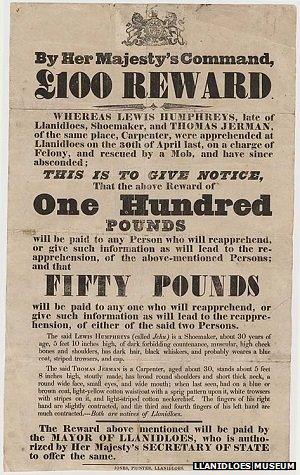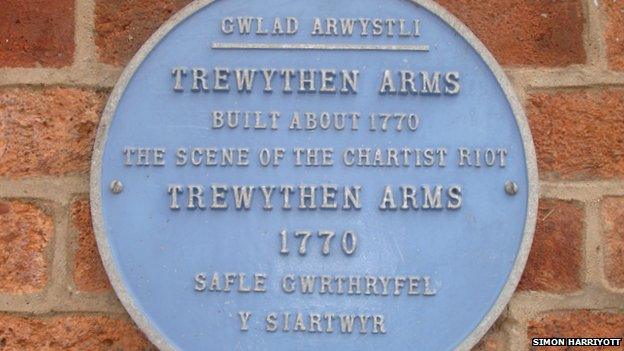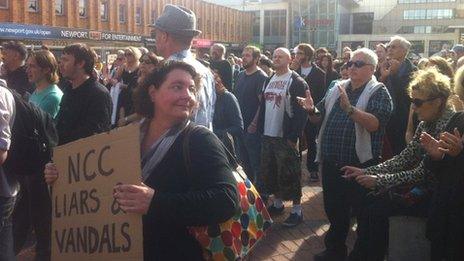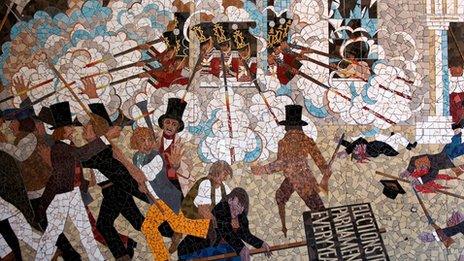How Llanidloes was captured by Chartists 175 years ago
- Published

Chartists attacked the Trewythen Arms to free three riot leaders captured by police
Mention Chartism in Wales, and most people would immediately think of the Newport Uprising of November 1839.
Yet six months before John Frost's last stand - 175 years ago this week - the seeds had been sown around a hundred miles away, in the Powys town of Llanidloes.
What started out as a peaceful protest for universal voting rights for men on 30 April 1839 ended up with a Chartist mob seizing control of Llanidloes for five days.
Self-employed weavers in Llanidloes's flannel industry were being put out of work by mechanised factories, and at the same time prices were rising.
As only 3% of the town were able to vote, the workers turned to peaceful protest to raise their issues.
Ostensibly the riot began when constables drafted in from London arrested three Chartist ringleaders - Abraham Owen, Lewis Humphreys and Thomas Jerman - and imprisoned them in the town's Trewythen Arms hotel, external.

A reward was offered for the capture of the rebels
An angry crowd overpowered guards, sacked the hotel and freed the three men.
But as Pam Smith, curator of Llanidloes Museum, external explains, all wasn't necessarily as it seemed.
"A local landowner, TE Marsh, had drafted over a hundred special constables from amongst his reluctant tenants, effectively pitting neighbour against neighbour," she said.
"Some sources say that when it looked as though this was going to backfire on him, it was Marsh himself who threw the first stone and started the riot, so he could escape to Shrewsbury and raise the alarm.
"You have to remember that for some the French Revolution was still in living memory, and the ruling classes were petrified at the potential for the same thing to happen here."
It took until 4 May for soldiers to arrive and restore order.
Outside the town, "wanted" posters were put up offering rewards for the capture of the three escaped men and other known Chartist leaders.
But with Mr Marsh and his constables ejected from Llanidloes, inside the atmosphere was said to have been good-natured and festive.
The period was named the "Five Days of Freedom", and a mould was even cast to strike coins for an independent Llanidloes.

Thomas Jerman (seated left) escaped to America where he settled and had a family
However, when the troops did eventually arrive, they met very little resistance.
Ms Smith said: "I think even the most ambitious Chartists knew that they'd never be able to hold Llanidloes for very long, so by the time the soldiers entered the town the feeling seems to have been that the protest had already made its point and there was nothing to be gained from a pitched battle they couldn't win."
Thirty three people, three of them women, were either imprisoned or transported to Australia in the months which followed.
Two of the ringleaders - Abraham Owen and Lewis Humphreys - were among those captured and sent Down Under.
But the third - Thomas Jerman - escaped via Liverpool to America where he settled and had a family, fighting in the American Civil War of the 1860s for the North.
A military garrison remained in Llanidloes for the next year, though there was never a repeat of the disturbances.
Whilst on the face of it little had been achieved, the uprising could be seen as paving the way for the more famous, and ultimately more successful, Chartist protests.

A plaque commemorates the role of the Trewythen Arms in the Chartist rebellion in Llanidloes

The Trewythen Arms survives to this day and is now the Trewythen Hotel
- Published5 October 2013

- Published31 May 2013
